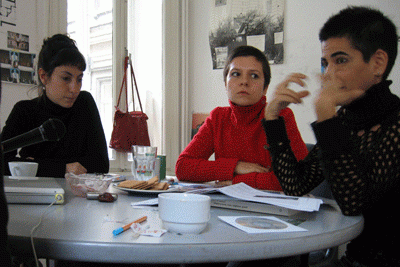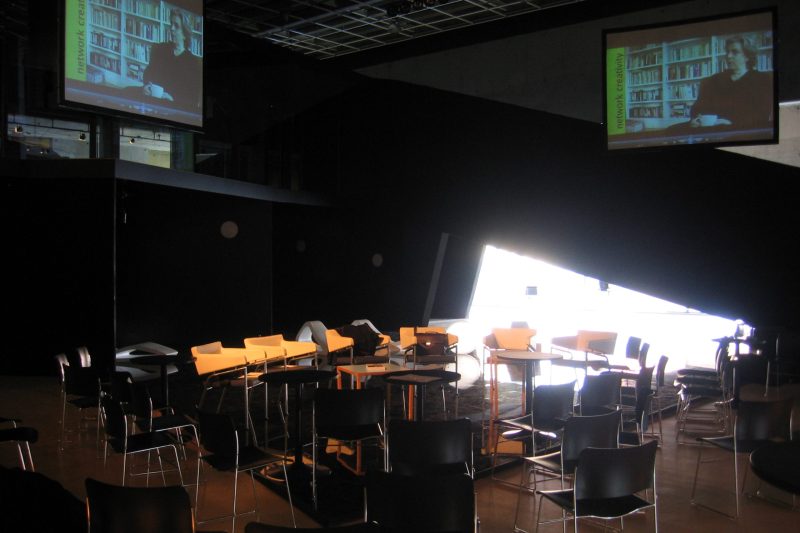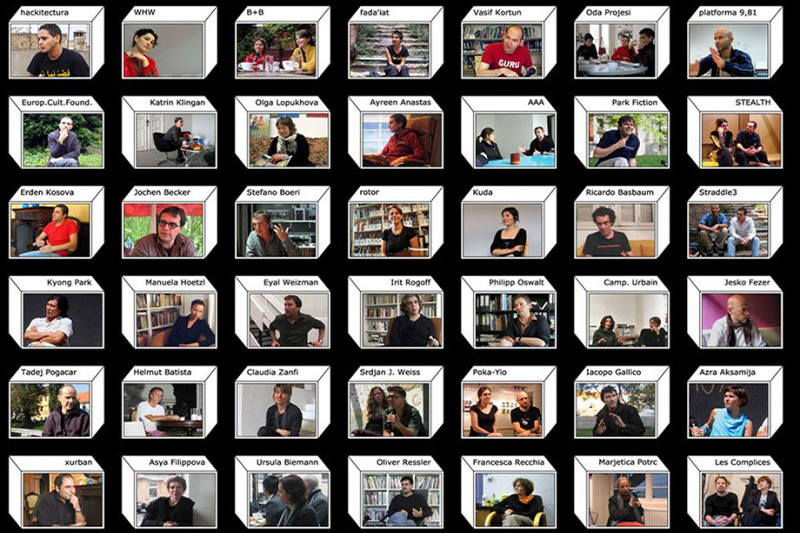- Interview
- Barcelona
- NETWORKED CULTURES
conversation with Joan Escofet and Josep Saldana
PM/HM: In 2000 you initiated the multifaceted context weblog that samples new cultural context. How does this online network relate to other activities of the Straddle3 collective?
Josep Saldaña: Straddle3 works in the ubiquitous and pervasive realm of architecture and urban computing. An initial moment in building the network was a series of events that we did, called Openfridays (www.straddle3.net/openfridays). We began with an appropriate tool – the context weblog (www.straddle3.net/context) – an emerging cultural observatory that offers information about art, science and technology, and has several formats. Actually, these weblogs are “information capsules” and we published them every week between 2000 and 2006. They constitute the basic material for our other projects; it’s like a research continuum that provides us with theories and practices for thinking about more commercial projects or for people who ask us to do something. We have developed it all by mapping, sampling and experiencing new cultural contexts. In fact, context weblog allows us to research and train how we do things in relation to a networked view of the world, and this is the most important factor. In the process, we’ve developed related projects that permit us to extend our investigations to social networks. This was also the point of departure for Openfridays, an event that enabled the creation of different social networks in Barcelona. For example, we’re now in Can Ricart, the oldest industrial complex in the city and one that the authorities would like to destroy. Industries and creative spaces are located in this industrial complex. The synergies in it are very interesting and it’s a very good place to be. It’s something we want to retain and not demolish. Obviously, the City Council’s problem with the complex has to do with aesthetics, as it would like it to be cleaner and more directly integrated into Poblenou, an industrial neighbourhood that is being gentrified for the new economy… It all has to do with money.
Joan Escofet: My architectural interest relates to the energies here (www.nau21.net). Walking down the street, you can find people who are working close by and with whom you might collaborate. It’s easiest to build a network, if you can actually see one another. We’re happy with virtual networks but real networks mean communicating face to face. And even though it seems that collaboration is possible with literally everyone around the globe, physical contact is something that drives networks forward.
Josep Saldaña: This is one of the characteristics of scale-free networks. There are nodes that have a lot of links and others that have a few. It’s by consciously making use of these features that we can construct networks adapted to different projects. Openfridays, for example, was part of Dorkbot Barcelona (www.dorkbotbarcelona.org), where people do strange things with electricity. It’s now a global network. It’s a very concrete network for electronic artists. At the same time, we can contribute to the ParcCentralPark network, which deals with problems of urban public space in our area (www.citymined.org/projects/parccentralpark.php). Our experiments have made me understand these projects as a kind of laboratory for context weblog. On another scale, they also work as urban laboratories for testing ways for the city to grow. Actually, humankind has become an urban species. Urban issues are extremely relevant for all of us.
PM/HM: Your context weblog highlights processes of sampling as an integral part of networks. What potential does work from others have for you?
Josep Saldaña: For me, the work of others is our very basis. What we’re doing is absolutely impossible without the network, without the work of others. We use contemporary tools – aggregating knowledge that people wish to share with others. This is the most important phenomenon today: the sharing of knowledge, i.e. cooperation and open content. In fact, context weblog is a remix of different materials that are in the network. Of course, it also involves our own work, our own contribution, but the materials for building the blog are in the network, and we respect and always credit the work of others. Knowledge and advancement are impossible without cooperating together. For me, competition makes no sense in this field.
Joan Escofet: The building blocks are actually the people themselves. For each project you can think about the different profiles of those who might be able to bring together what you need to build something. That’s how we work: context weblog, for example, wouldn’t exist if it weren’t for the aid of a programmer we met through our involvement in Indymedia Barcelona (barcelona.indymedia.org). It’s about meeting someone in one project and then collaborating with them on something else. Though we also see all the competition and we talk about it sometimes – because for us it’s strange that people working in open contexts are susceptible to running after fame.
Josep Saldaña: At the root of this kind of competition is the problem of the evolution of content, of knowledge, which is so accelerated that it throws previous business models into a crisis. How to survive in this new era? I think the only way is by continuing to share content. In fact, the web shows that content is not a static, closed product, and has become more open, context aware and socially embedded. It’s a whole different era. The same goes for architecture. Maybe one day we’ll be able to design context-aware architecture, in all senses of the word – because the topics we’re pursuing in context weblog are ones that will obviously affect contemporary architecture. For example, the oil crisis or climate change, cross-cultural phenomena or the ubiquity of computing. All these things already affect, should affect or will one day affect contemporary architecture.
PM/HM: This notion of shared knowledge and competence also lies at the heart of Fada’iat, an ongoing project that tries to set up a self-organised and uncensored exchange of information across the Straits of Gibraltar. What role can architecture play in such an endeavour?
Joan Escofet: With Fada’iat (www.fadaiat.net) we collaborated in different ways. The most important involved designing a project called the Observatory of the Straits, which was conceived as a media lab observatory and was to be built in an old castle in Tarifa (Spain). We presented this project together with hackitectura and other groups to Tarifa’s City Council. The prototype for it was developed for a patio at the Castle of Guzmán el Bueno in Tarifa in 2004. This is an ongoing project that still has to be implemented.
Josep Saldaña: Actually, each part of the world is a synthesis of the whole. Many European cities have become extremely important Islamic or Arab cities and it’s not important if such a city is in the north or the south. I think this isn’t relevant anymore. Contact between Tangier and Barcelona can be more intense than between Tangier and Tarifa, which are geographically but not necessarily emotionally closer. Moreover, people’s imaginations in Tangier can be more similar to those in Barcelona than to those in the south of the country. Paradoxically, such locations are very important. Just think of New Orleans and the people living there. Then again, people in these places move often. We’ve close contact with the whole world and with specific locations at the same time. This generates conflict and tension but also opportunities for architecture.
Joan Escofet: This kind of nomadic life has its own needs. I think the prospects are good for services conceived for contemporary life. Our own work is affected by locations and places, too. But I think we’ve more in common with a number of projects whose roots go back to the US than to the city we’re working in. We’ve more regular personal contact with people there than here, for instance, with the people from Leonardo, a network and journal on art, science and technology that has existed since 1968. In some ways this affects how open we are, but in others it doesn’t. Networks facilitate contact with people who are on the same wavelength and it doesn’t matter where you live.

Joan Escofet
was born in 1965 and is a member of straddle3. He takes a special interest in the complex configuration of the inhabited environment. Trained in architecture and art, he has developed projects that deal with the construction of architectures, content structures and visual images in different formats and that establish a visual dialogue and call for a personal alchemy of meaning.
Josep Saldaña
was born in 1956 and works as an independent analyst/programmer. He is a main contributor to the projects Context and Openfridays. Devoted to net-driven research and development, Openfridays seeks to appropriate and disseminate emerging culture as a new art de vivre. From 2004 to 2007 he actively participated in urban movement around Can Ricart/Parc Central in Barcelona.


